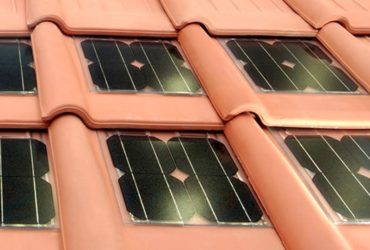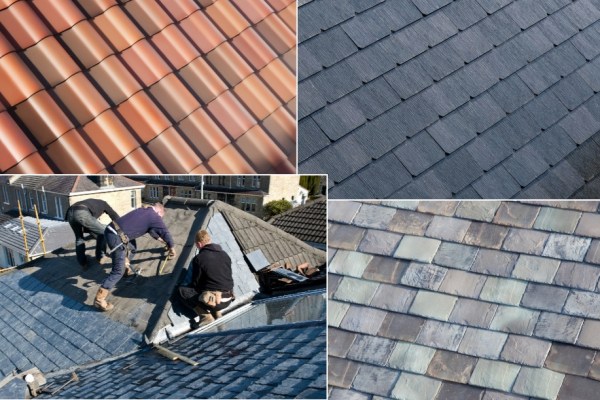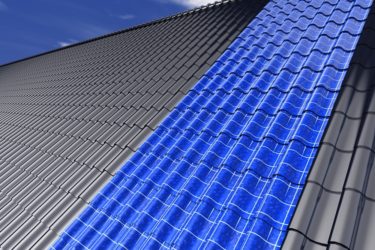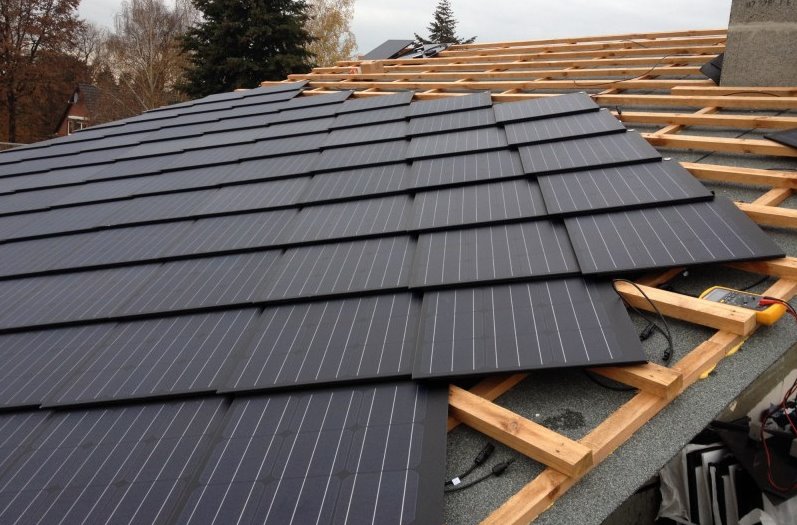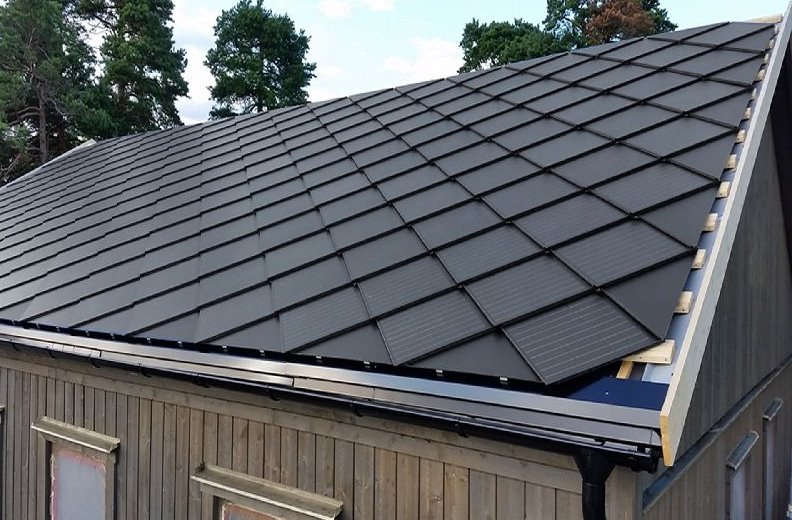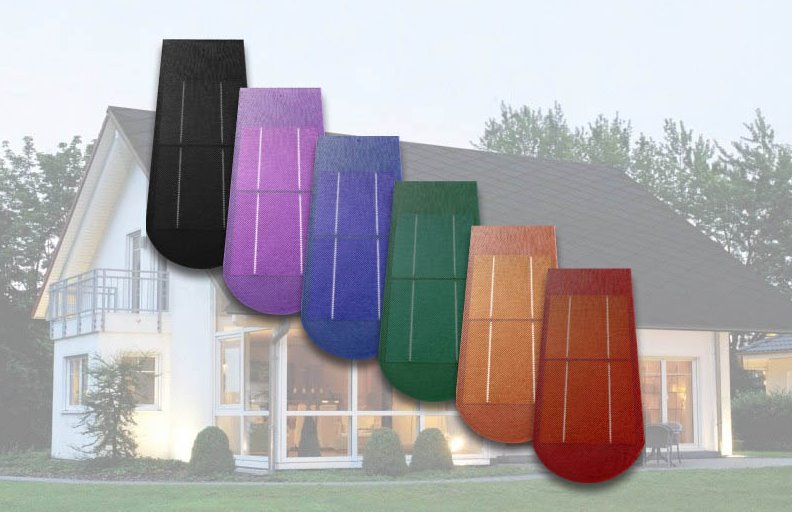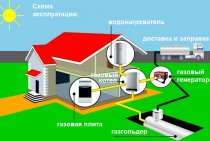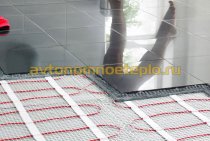New solar panels in the form of roof tiles
Numerous solar panels installed on the roofs of buildings and structures, just like satellite dishes, hardly make these buildings aesthetically attractive in both cities and villages. In an effort to eliminate this shortcoming, engineers working in this field are creating new forms of photoconverters that are fundamentally different from traditional ones. There were coatings from the so-called Gretzel cells, from polymer films, solar panels appeared in the form of tiles. This decision seemed so successful that several manufacturers in the world decided to master this direction at once.
Breakthrough technologies in the manufacture of the first Russian solar tiles
The Anapa company Innovatics has started the final stage of the Solar Roofs of Russia project. Installation of equipment for the production of domestic solar tiles has begun. The first prototypes of 8 W shingles have been laboratory tested.
The synergistic effect of innovative solutions adopted in the creation and manufacture of tiles has achieved competitive results that have no analogues in the world. Russian tiles are more than five times cheaper than any foreign similar product per 1 kW of generated power. Similar results have been achieved through the use of a special optical system that repeatedly amplifies the light flux to solar photocells, vacuum processing technology, the use of composite materials based on recycled polymer waste and low consumption of semiconductor material. In the manufacture of solar tiles, a 100% degree of localization has been achieved.
The creation of domestic production of solar tiles is a new stage in the development of the use of solar technologies, which will significantly reduce costs not only in the construction and operation of facilities, but will also have a stimulating effect on economic growth, especially in certain and energy-deficient regions of the country. In Russia, about 70% of the territory does not have a centralized energy supply. More than 30% of the country's 280,000 farms and about 20% of the country's orchards have been established on plots of land without power grids. In 40 out of 70 power systems there is a shortage of capacity, which holds back the growth of the economy in these regions. Moreover, the wear of the power grid infrastructure, as you know, in some housing and communal services reaches 60 - 80%.
Innovatics plans to produce more than 20 MW of solar tiles per year. This amount of power, for example, is sufficient for autonomous power supply from 3,500 to 5,000 residential buildings with an average total area of 150-200 sq.m. To obtain 1 kW of electrical power on the roof, it is necessary to lay 14 m2 of solar tiles.
In the shady part of the roof, an ordinary tile without photocells is mounted. Consumers will simultaneously receive not only a competitive autonomous energy supply, but also a unified architectural concept of roofing, and at a cost it will be affordable for a wide section of the employed population. The price and innovation leadership of this product will ensure its successful promotion to the markets of foreign countries that actively use renewable energy sources in their energy balances of production and consumption.
The tile has protection against UF, is ecologically safe, fireproof. Temperature mode of operation -40 +80 °С. Protective measures are provided for solar roofs from snow, hail, pollution, foliage. The guaranteed term of operation of a tile is 50 years.
The use of domestic solar tiles will allow developing a number of measures aimed at the implementation of regional and municipal energy saving and energy efficiency programs, as well as programs to reduce the negative impact on the environment. The Solar Roofs of Russia project has proved its investment attractiveness and innovative potential. The developers of the project set themselves a new task: to organize the production of a new unique product - solar tiles with a power of 20 watts, which will simultaneously produce both electricity and hot water for heating and household needs.
The latest government documents of the Russian Federation in the field of stimulating the use of renewable energy sources (RES), world events, including sanctions, and the crisis, and difficult times in our country - all this further activates the Innovatics team for creative activities to reproduce new domestic innovative products. And we are confident that we bring and promote to the market for our consumer a new highly effective benefit, new types of modern services that will help solve both regional, sectoral and private problems of people.
Solar tiles Tesla Solar Roof instead of conventional roofing video
25.07.2019

The idea to turn the roofs of houses into solar panels was literally in the air, because traditional solar energy storage devices are installed on the roof everywhere. But only Elon Musk managed to translate this into a working project with commercial implementation. As you know, Tesla Motors, the creator and leader of which is Musk, took over SolarCity for $ 2.6 billion.
Previously, the startup worked on various projects with a common goal: to make solar energy easier and closer to the end user. The collaboration between Tesla and SolarCity has resulted in a new roof for the company's electric vehicles, which allows you to think less about recharging your car, and the second, louder and more effective product is an innovative roof material called Solar Roof.
Solar Roof - characteristics and principle of operation
In appearance, the new material is ordinary tiles, which are enough on the market. It is available in four variations: textured (Textured Glass), slate (State Glass), Tuscan (Tuscan Glass) and matte (Smooth Glass). In fact, this is a high-tech coating that can, if not completely replace the external power supply, then significantly save it. To date, there are no direct competitors in this area, which, together with the growing popularity of projects based on alternative energy sources, has made the new product ultra-popular.
Solar Roof is based on glass ceramics, the production of which has long been established and does not cause difficulties. A special coating has been introduced inside the material, which allows you to accumulate solar energy and transform it into electricity. Together with the Powerwall Home Generator that comes with the roof, the roof makes efficient use of all the sunlight that hits the building.
Compared to traditional solar panels, the new material is only 2% less efficient, but work is already underway to level the difference and make the coating as productive as possible.
Implementation and price
According to Elon Musk, the company is doing everything so that people do not have a desire to purchase not Solar Roof, but another coating. And there are all the prerequisites for this:
– glass ceramics is an extremely durable material that can serve for decades without losing its appearance and qualities. Musk claims his shingles will last longer than the house itself;
— excellent appearance which provides a covering will suit even the most exacting user. Moreover, the textures presented at the presentation are just the beginning, and by the time of the commercial release there will be much more of them;
— affordable cost is the main advantage of Solar Roof.
If earlier it was said that innovative roofing is an investment in the future, and over time, due to the accumulated energy, it will be able to pay for itself, today Elon Musk claims that the new material is cheaper than traditional coatings, even without taking into account savings on electricity. Simply put, it is profitable to buy it immediately, without waiting for payback.
In fact, potential buyers should not have a question at all: low cost, durability, excellent appearance, as well as the ability to save on electricity using environmental technologies and renewable sources. Who needs something else?
According to Tesla, the average cost per square meter of a solar roof is $235 ($21.8 per foot2), but this is for cases where not all roof tiles will be equipped with solar panels. For optimal effect, the company suggests combining shingles with integrated photovoltaic cells ($42 per ft2) with regular tiles (11 per ft2). Moreover, outwardly, tiles with solar panels will look like ordinary tiles: from the ground, the difference will not be noticeable to the naked eye at all.
Benefits and problems of solar roof tiles
Solar shingles combine the benefits of solar energy with the reliability of traditional roof shingles.
Solar shingles can also be used as a durable roofing material, providing the same environmental protection as regular shingles.
If your client is looking for an alternative that can be aesthetic and generate electricity at the same time, this might be the right fit for them.
This is a trend that is being implemented in many areas of the country instead of solar panels, benefiting from building their own power. Can solar shingles be the main roofing material?
Many solar tile manufacturers will allow you to use shingles as your primary roofing material, and yes, you don't need anything more than the shingles themselves.
Some of these shingles can be waterproof, which means that water will not enter your client property, and at the same time, it can be used as the main energy source for the building.
Many solar tile manufacturers can provide a detailed installation process that reduces roof penetration by 10% and reduces wind disturbance.
These shingles can be installed on almost any existing roof, but are probably best when installed as part of a new roof.
Benefits of Solar Shingles
There are many benefits to using solar roof tiles and these are some of the main ones:
- They can be integrated into any exterior design of your home.
- They look like ordinary tiles.
- This eliminates the need for large surfaces for traditional solar panel installation.
- Aesthetically pleasing solar material.
- Solar shingles come in a variety of sizes and patterns; solid pebble panels, semi-rigid silicon cells and thin solar film systems.
- Easy installation can be done by stitching the material on the roof.
- You may qualify for tax credits when installing solar shingles, depending on your government policy.
- Can be combined with conventional asphalt shingles.
- Solar shingles, if installed correctly, can withstand strong winds.
- As a newer material, they are more efficient than traditional panels.
- Can cover large areas compared to traditional solar panels.
- Some photovoltaic roof tiles can produce around 13-17 watts of electricity.
Solar shingles will generate electricity that can be used in grid or off grid systems.
Grid systems are used to provide electricity to power plants and buildings; and sell excess electricity not consumed by the utility company.
Off-grid systems are typically used as a backup during a power outage and to store electricity in batteries for future use. Battery equipment is more expensive than grid systems.
The system generates the current generated by the solar tiles and is transmitted to the power converter.
This power converter converts direct current (DC) to alternating current (AC) for home use.
The cost of installing shingles is high, and many homeowners tend to neglect installing the system.
However, new designs can be installed in half the time than traditional solar panels, reducing their installation cost.
Depending on the area, shingles usually pay for themselves during the first few years of their 20 year lifespan.
A new alternative on the market will allow you to pay a monthly or yearly fee to make the product more affordable.
Disadvantages of Solar Shingles
Like any product, solar roof tiles also come with some disadvantages such as:
No energy storage. There is no energy storage in these systems and you will have to rely on the power grid during storms or at night.
Your roof needs to be at a certain angle to catch the sun.
For solar shingles to catch the sun's rays enough to generate electricity, your roof needs to be at right angles with enough surface area to power your building.
If possible, install shingles during the building or remodeling process of your unit. The cost of installing solar shingles can be steep.
Germany's SolteQ offers solar shingles at the price of a conventional roof
03.11.2019
Creation of a full-fledged roof, which not only reliably fulfills its main purpose, but is also capable of becoming a home decoration, producing electricity and heat, having a service life of at least 50 years and the cost of a conventional roof (which already includes an integrated solar power plant)
The goal of the German company SolteQ and its founder Berkay Bayer, who, like Tesla, intends to transform energy through solar roofs. But unlike the products of an American competitor, a German product may be more effective and affordable.
Although solar tiles had been developed for a long time, they were not ready for large-scale mass production and were only sold in limited quantities. Thanks to our many years of experience in the industrial sector, we have developed a roof covering that is 100% compliant with German building codes, and all panels come with security systems already integrated into them.”
The company focuses on German quality and boasts that its products do not use cheap components from Asian countries. The variety of available options is ensured by the presence of tiles made in various colors and styles.
“We don't offer dumped Chinese goods, we offer excellent products, maximum power generation at a reasonable price, which is affordable for everyone who can afford a new roof with solar panels installed on it,” explains the head of the company.
SolteQ has developed complete roofing solutions for houses. This means that the southern (sunny) sides of the roofs are equipped with solar cells, and the northern (shaded) sides are covered, which does not have built-in photocells, but has a completely identical appearance. In addition, according to the manufacturer, the SolteQ roof generates not only electricity, but also thermal energy: in addition to the photovoltaic system, the entire roof area is used as a large heat collector.
Declared technical characteristics of roofing modules SolteQ Quad40 (premium segment): weight – 14 kg per 1 m2; photocell material - single-crystal silicon; module size - 540x540 mm; productivity - from 173 to 208 W per 1 m2; efficiency of photocells - 18.8 -19.8%; nominal voltage - 4.7 V; rated current - 8.75 - 9.0 A; service life - more than 40 years; warranty - 5 years.
The cost of a SolteQ solar roof depends on many factors (tile type, angle of inclination, area, type of roof, additional features, etc.) and is calculated individually.
